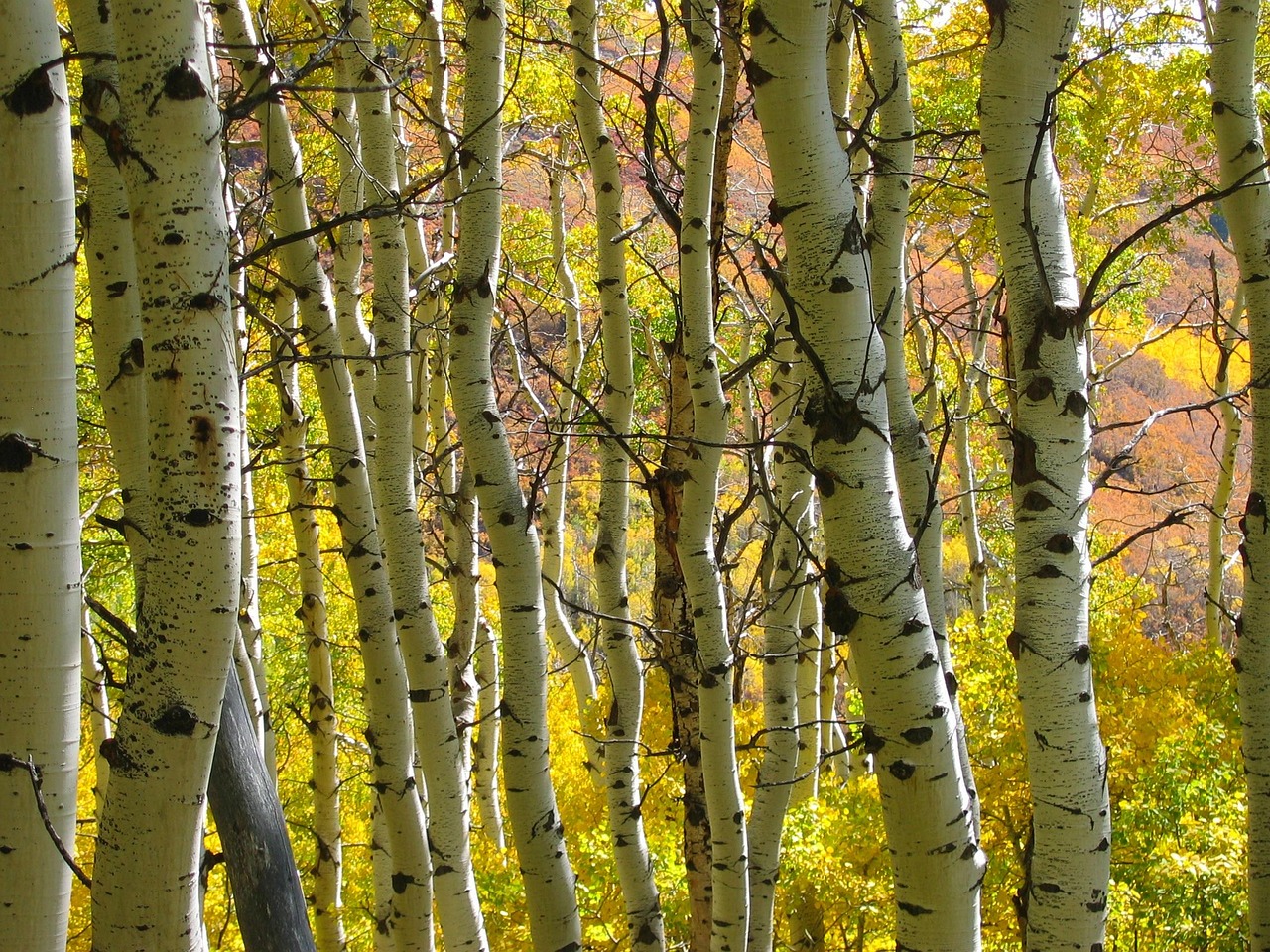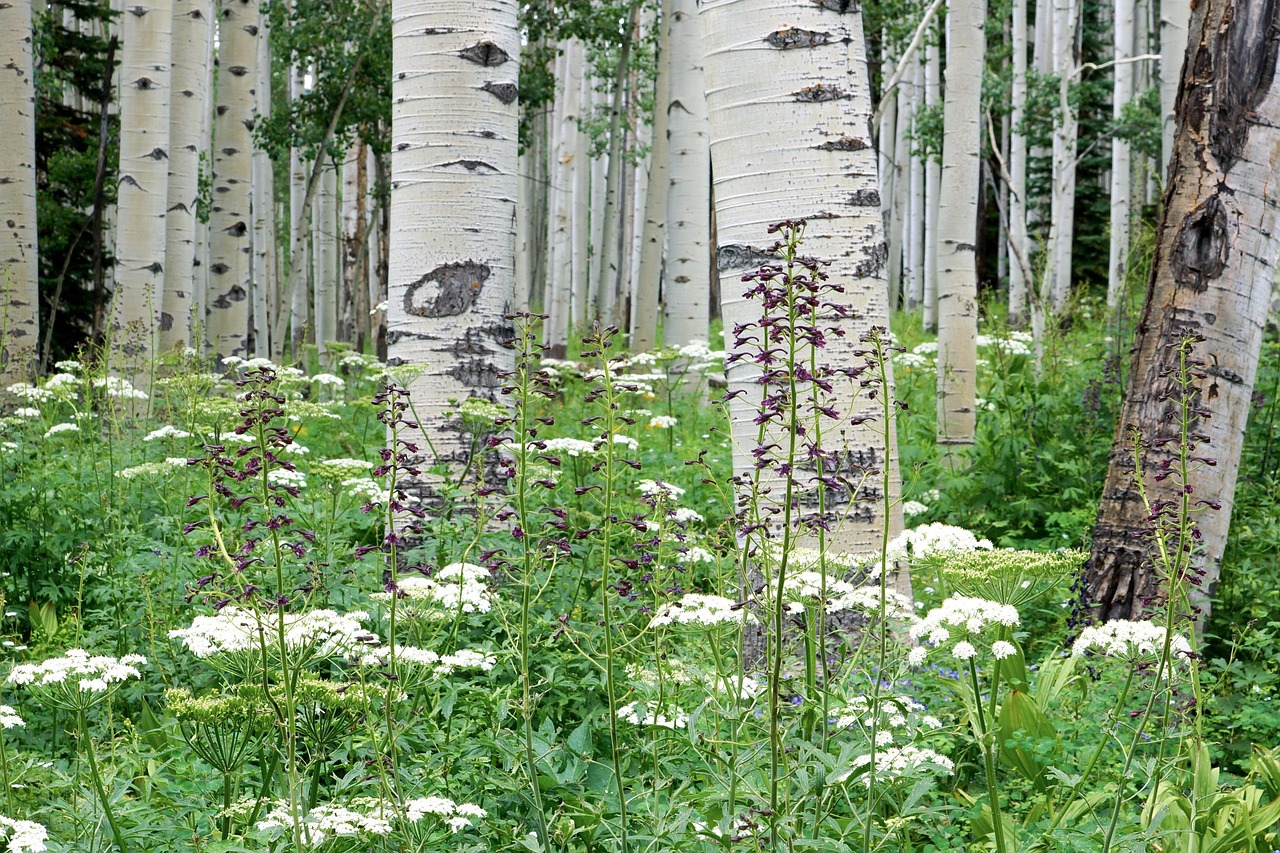Quaking aspens are known for their distinctive leaves that tremble or quake in the breeze. This unique characteristic is primarily due to their flattened petioles, which allow the leaves to catch the wind easily. The quaking motion also helps reduce water loss and improves light capture for photosynthesis.
Introduction to Quaking Aspens

Quaking aspens, scientifically known as Populus tremuloides, are a species of aspen tree native to North America. They are easily recognized by their white bark and vibrant green leaves that turn a brilliant yellow in the fall. These trees thrive in a variety of environments, from mountain ranges to valleys, and they often form large groves through their extensive root systems.
The name “quaking” is derived from the movement of their leaves, which tremble in the wind. This phenomenon is not just visually striking; it serves several important functions for the tree’s survival. Understanding why these trees exhibit this behavior can provide insight into their biology and ecology.
Aspen trees are among the fastest-growing trees in North America. They can reach heights of up to 80 feet and live for about 30 to 50 years. Their ability to propagate through root suckers allows them to form dense stands known as clones, which can be genetically identical. This characteristic contributes to their resilience and adaptability in various climates.
Key Characteristics of Quaking Aspens
Quaking aspens possess several key features that set them apart from other tree species. These characteristics contribute to their unique habitat requirements and ecological roles.
| Characteristic | Description |
|---|---|
| Leaf Structure | Flat petioles enable easy movement in the wind. |
| Growth Habit | Fast-growing and capable of forming large clones. |
| Bark Color | White bark with black knots, providing a striking appearance. |
| Fall Color | Leaves turn golden yellow in autumn, enhancing landscape beauty. |
These characteristics make quaking aspens not only an essential part of their ecosystem but also a favorite among nature enthusiasts and photographers. The trembling leaves create a shimmering effect that adds beauty to landscapes, especially during sunny days.
In addition to their aesthetic appeal, quaking aspens play a vital role in their ecosystems. They provide habitat and food for various wildlife species, including birds, deer, and small mammals. The trees are also important for soil health, as they help anchor soil and prevent erosion.
The ecological significance of quaking aspens cannot be overstated. Their ability to adapt to different environmental conditions allows them to thrive in diverse habitats. This adaptability is partly due to their unique leaf structure and growth habits, making them a fascinating subject for study in forestry and ecology.
Mechanism Behind the Quaking Leaves
The quaking motion of aspen leaves is primarily attributed to their unique petiole structure. Unlike many other trees, the petioles of quaking aspens are flattened rather than round. This design allows the leaves to catch the wind easily, creating a tremble effect even with gentle breezes.
When wind passes through the leaves, the flattened petioles act like a sail. This allows the leaves to sway with the wind’s direction and intensity. As a result, the leaves appear to dance and shimmer, creating a captivating visual display.
There are several factors that contribute to this quaking phenomenon:
- Leaf Shape: The oval-shaped leaves have a large surface area that enhances their ability to catch the wind.
- Petioles: The flattened shape of the petioles reduces drag and allows for easier movement.
- Branch Structure: The flexible nature of the branches allows them to bend under wind pressure without breaking.
Ecological Benefits of Leaf Quaking
The quaking motion of aspen leaves serves several ecological purposes, contributing to the overall health of the tree and its surrounding environment. These benefits include:
- Water Conservation: The trembling leaves can help reduce water loss through transpiration. When leaves move, they can create slight changes in airflow, which may help retain moisture in the surrounding area.
- Light Capture: The movement of the leaves can enhance light capture. As the leaves quiver, they present different angles to the sun, maximizing photosynthesis throughout the day.
- Deterrent to Herbivores: The constant movement can make it more difficult for herbivores to feed on the leaves. The trembling can be perceived as a sign of danger, potentially deterring animals from approaching.
Adaptations to Environment
Quaking aspens have developed various adaptations that enable them to thrive in diverse environments. These adaptations make them resilient against environmental stresses and contribute to their widespread distribution across North America.
Some key adaptations include:
- Root System: Quaking aspens possess a shallow but extensive root system that allows them to quickly absorb water and nutrients from the soil. This is especially beneficial in areas with limited water availability.
- Clonal Growth: Aspens can reproduce asexually through root suckering. This means that when a parent tree is damaged or dies, new trees can sprout from its roots, ensuring survival and continuity of the grove.
- Cold Hardiness: These trees are highly adaptable to cold climates. They can withstand freezing temperatures and often thrive in snowy regions.
Cultural Significance of Quaking Aspens
Beyond their ecological importance, quaking aspens hold cultural significance for various communities. Many Indigenous peoples view aspens as sacred trees. They have been used for traditional medicine, crafts, and rituals. The wood is lightweight and strong, making it ideal for crafting items such as snowshoes and fishing nets.
The aesthetic beauty of quaking aspens also makes them a popular choice for landscaping. Their striking white bark and vibrant fall colors enhance gardens and parks across many regions. Furthermore, photographers and nature lovers often seek out these trees for their stunning visual appeal.

In summary, the quaking aspen is not only a beautiful tree but also an essential component of its ecosystem. Its unique leaf motion provides both ecological benefits and cultural significance, demonstrating the intricate connections between nature and human culture.
Environmental Impact of Quaking Aspens

Quaking aspens play a significant role in their ecosystems beyond their aesthetic and cultural value. Their presence can influence soil health, water cycles, and biodiversity in various habitats.
Soil Health
The root systems of quaking aspens contribute to soil stability and health. As they grow, their roots help to anchor the soil, reducing erosion and promoting nutrient retention. The decaying leaves and bark also enrich the soil with organic matter, which benefits other plants and organisms in the area.
- Nutrient Cycling: The fallen leaves decompose and return nutrients to the soil, enhancing its fertility.
- Soil Structure: The roots improve the soil structure, leading to better water infiltration and aeration.
- Erosion Control: The extensive root network helps prevent soil erosion, particularly in areas prone to landslides or heavy rainfall.
Water Cycle Regulation
Quaking aspens also play a vital role in regulating local water cycles. They have a high transpiration rate, which can increase humidity and influence precipitation patterns in their surroundings.
The key ways in which quaking aspens impact the water cycle include:
- Transpiration: Through their leaves, aspen trees release water vapor into the atmosphere. This process can contribute to cloud formation and local rainfall.
- Water Absorption: Their root systems efficiently absorb water, helping to maintain groundwater levels during dry periods.
- Watershed Protection: By stabilizing soil and reducing runoff, quaking aspens help protect watersheds and maintain clean water resources.
Biodiversity and Habitat Creation
Quaking aspens provide essential habitats for a variety of wildlife species. Their groves create unique microenvironments that support diverse plant and animal life.
Wildlife Habitat
The dense stands of quaking aspens offer shelter and food for numerous species:
- Birds: Many bird species, such as woodpeckers, chickadees, and warblers, thrive in aspen groves. The trees provide nesting sites and abundant insects for feeding.
- Mammals: Deer, elk, and small mammals often forage on aspen leaves and bark. The trees also provide hiding places from predators.
- Insects: Aspen trees attract various insects that are essential for pollination and serve as food sources for other wildlife.
Plant Diversity
The presence of quaking aspens encourages the growth of understory plants. Their shade provides a suitable environment for specific plant species that thrive in partial sunlight. This diversity can include:
- Wildflowers: Many wildflower species flourish in the light conditions created by aspen groves.
- Shrubs: Various shrubs benefit from the protection of aspen trees, contributing to the overall biodiversity of the area.
- Herbs: Herbaceous plants often grow in the nutrient-rich soil around aspen roots, supporting more wildlife.
Threats to Quaking Aspen Populations
Despite their resilience, quaking aspens face several threats that can impact their populations and health. Understanding these threats is crucial for conservation efforts.
Disease and Pests
Quaking aspens are susceptible to various diseases and pests that can weaken or kill trees. Some common threats include:
- Forest Tent Caterpillar: This pest can defoliate aspen trees, leading to stress and potential mortality if infestations are severe.
- Fungal Diseases: Fungi such as Cytospora can infect aspen trees, causing cankers that may eventually kill them.
Climate Change
Changes in climate patterns present a significant challenge for quaking aspens. Rising temperatures and altered precipitation patterns can affect their growth and distribution. Additionally, increased frequency of droughts can stress these trees, making them more vulnerable to pests and diseases.
Habitat Fragmentation
Development and land use changes can fragment aspen habitats, isolating tree populations. This fragmentation can limit genetic diversity and hinder their ability to adapt to changing environmental conditions.
Conservation Efforts for Quaking Aspens
Given the various threats quaking aspens face, conservation efforts are essential to ensure their survival. Several strategies are being implemented to protect these trees and their ecosystems.
Restoration Projects
Many organizations and government agencies are actively engaged in restoration projects aimed at preserving existing aspen stands and promoting new growth. These projects may include:
- Reforestation: Planting new aspen trees in areas where they have been lost due to disease, pests, or land development helps restore natural habitats.
- Controlled Burns: In some cases, managed fires are used to clear competing vegetation that may inhibit the growth of aspen saplings.
- Monitoring Programs: Regular assessments of aspen health and population dynamics help identify problems early, allowing for timely intervention.
Community Engagement
Community involvement is crucial for the success of conservation initiatives. Educational programs and volunteer opportunities can foster a sense of stewardship among local residents. These initiatives may include:
- Workshops: Workshops on the importance of quaking aspens and how to care for them can raise awareness and encourage responsible land management practices.
- Citizen Science: Engaging the public in monitoring tree health and reporting pest outbreaks can aid researchers in gathering valuable data.
The Role of Research in Aspens Conservation

Research plays a vital role in understanding the biology and ecology of quaking aspens. Ongoing studies focus on various aspects, including:
- Genetic Diversity: Researching the genetic diversity within aspen populations can inform breeding programs aimed at developing disease-resistant varieties.
- Pest Management: Studying the interactions between aspens and their pests can lead to more effective management strategies that minimize harm while preserving ecological balance.
- Climate Resilience: Understanding how quaking aspens respond to climate change can help develop adaptive management practices that enhance their resilience.
Final Thoughts
Quaking aspens are remarkable trees that contribute significantly to their ecosystems through their unique characteristics and ecological roles. Their distinctive quaking leaves not only provide visual beauty but also serve vital functions in water conservation, soil health, and biodiversity promotion.
However, the threats they face from climate change, disease, and habitat fragmentation highlight the need for proactive conservation measures. Through restoration projects, community engagement, and ongoing research, we can work towards ensuring the survival of quaking aspens for future generations.
By appreciating the ecological value of these trees and advocating for their protection, we contribute to a healthier environment. Quaking aspens remind us of the delicate balance that exists within ecosystems and the importance of preserving our natural heritage.
